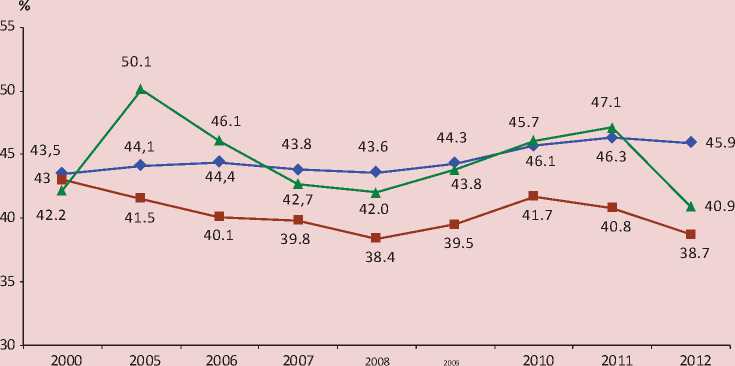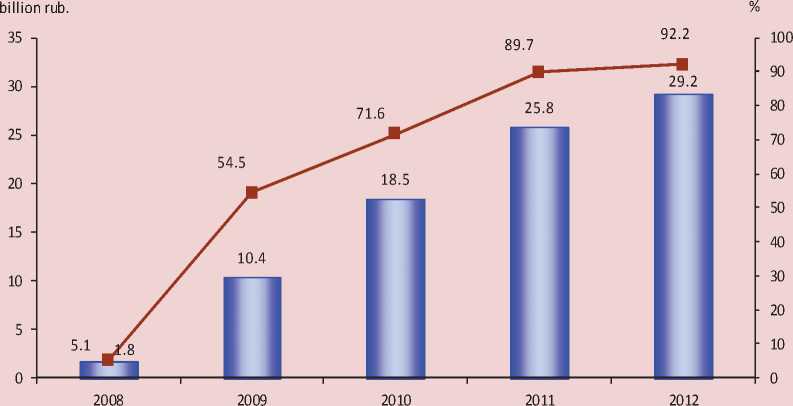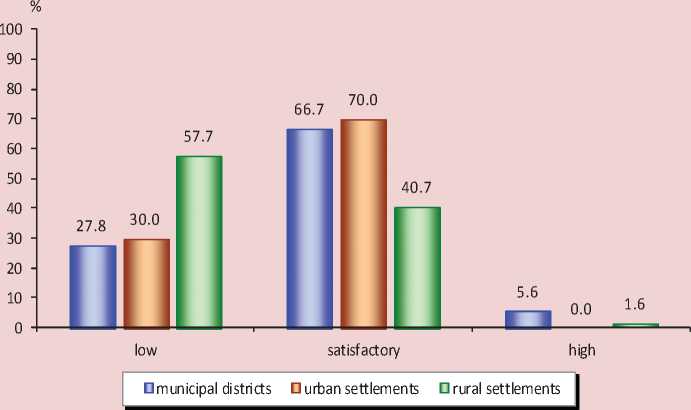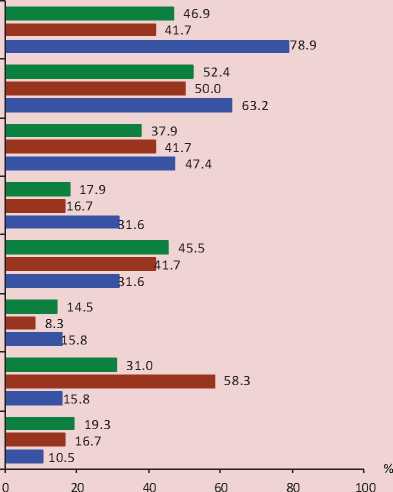Management of the regional economy on the basis of partnership interaction between the authorities and business structures
Автор: Uskova Tamara Vitalevna, Kozhevnikov Sergei Aleksandrovich
Журнал: Economic and Social Changes: Facts, Trends, Forecast @volnc-esc-en
Рубрика: Development strategy
Статья в выпуске: 6 (36) т.7, 2014 года.
Бесплатный доступ
The article studies the theoretical and practical aspects of the management of the region’s economy on the basis of interaction between the authorities and business structures. The authors prove that partnership is an optimal form of such interaction under the conditions of chronic budget deficit. Partnership facilitates the achievement of strategic goals of the territory’s development and structural adjustment of domestic economy; it also enhances the interest of the parties in achieving successful results of cooperation, and helps attract innovation technology and significant extra-budgetary investments in the economy. In addition, as world experience shows, public-private partnership is an effective tool to remove infrastructure constraints to economic growth, to improve the availability and quality of public services. The article shows that at present the development of partnership between the government and business is hindered by a number of organizational, legal and financial-economic problems and barriers. The authors identify priority directions for regional public policy and propose several measures to use the available potential of cooperation for dealing with territorial development issues.
Regional economy, partnership cooperation between the authorities and business structures, public-private partnership (ppp), investments, infrastructure
Короткий адрес: https://sciup.org/147223680
IDR: 147223680 | УДК: 338.24(470.12) | DOI: 10.15838/esc/2014.6.36.3
Текст научной статьи Management of the regional economy on the basis of partnership interaction between the authorities and business structures
Decentralization of power and increase of autonomy of the territories in the solution of socio-economic development tasks turn them into full-fledged economic entities that compete for human, financial, investment and other resources. These processes emphasize the task to find ways and new sources of growth of the regional economy for ensuring a high quality of life.
Under the circumstances a most important condition for the solution of these specific tasks is to consolidate the limited resources through the development of active cooperation between the authorities and business structures. The current world practice shows that partnership is an effective model of interaction between the authorities and business, because it helps to use competitive advantages of the parties (public and private sectors) more efficiently, to increase their interest in the successful achievement of the results of joint activities, to attract significant extra-budgetary funds and innovation technologies in the sphere of competence of the state [3, 5, 12].
Partnership is characterized by coherence and a certain balance of interests of the authorities and business structures, by regulation of their rights, responsibilities, cross risk-sharing, and joint and several liability. The economic nature of partnership implies close interaction between the participants to achieve their goals and perform all of their obligations. Only in this case there is the possibility to use synergistic effect that is achieved as a result of this cooperation due to the fact that each party has certain resources, access to which can be useful for the partners [10, 13, 16].
Thus, public-private partnership (PPP) is based on the use of competitive advantages of the parties and on a mutually beneficial exchange of available resources to achieve strategic goals for the territory’s development (fig. 1).
Currently, public-private partnership is used most widely in neoliberal countries (U.S., UK, Ireland, Australia) in order to attract private business to provide services in the spheres that are traditionally within the competence of the public sector.
The United Kingdom is, undoubtedly, the leader by to the number of concluded projects and scope of partnership agreements. It accounts for more than half of PPP projects implemented in Europe. The Private Finance Initiative (PFI), a national program adopted in 1992 for attracting private investment in the economy, promoted the successful development of public-private partnership. Seven hundred and twelve agreements with a total cost of 54.3 billion pounds were implemented under PFI during 1992–2011.
Currently, the cost of completed joint projects under PFI is about % of the overall government investment in the country. At that, the social sphere is top priority in the implementation of PPP projects. Two hundred and sixty two projects in education and healthcare (which is 71% of the total number of partnership agreements) have been concluded during the implementation of PFI [5].
Other major PPP markets in Europe in 2011 comprised Spain (the value of partnership projects was 4.3 billion euros), Portugal (3.1 billion euros), France (1.8 billion euros) and Belgium (1.7 billion euros) [15]. The majority of the implemented projects are agreements in the transport sector, healthcare, defense, education, and telecommunications [1].
Figure 1. Structural-and-resource model of public-private partnership
AUTHORITIES
Economic and financial resources: provision of tax benefits and subsidies to business, compensation of interest rate on loans, etc.
Administrative and political resources:
-
- providing business with access to areas previously closed to entrepreneurial activity;
-
- lobbying of business interests
Information resources: creation of the positive company image in the eyes of the public and the business community

BUSINESS STRUCTURES
Financial resources: private financial and investment resources
Innovation resources: innovation ideas, projects, technology

PARTNERSHIP
-
- providing business with access to areas previously closed to entrepreneurial activity;
-
- lobbying of business interests

RESULTS OF PARTNERSHIP IMPLEMENTATION
Enhancement of the quality and accessibility (physical and economic) of the services
Reduction of the burden on the budget in the implementation of socially significant investment projects
Optimizing the number of management personnel of the government bodies
Enhancement of the efficiency of property management through the application of technical and managerial experience, innovation business technology, and a smooth mechanism for project management
Effective project risk management
Management resources: modern methods and technologies of project management
The aim to develop partnership relations between the authorities and business due to a great demand for investment resources for economic modernization has been put in legal form in Russia.
The adopted Concept for socioeconomic development of the Russian Federation until 2020 considers publicprivate partnership as a promising tool for innovation development of the key sectors of Russia’s economy (energy, agriculture, education) and for improvement of the quality of life. Besides, the majority of federal, regional and municipal strategies and programs for development of territories and industries provide for the use of partnership mechanisms.
Public-private partnership is applied mainly in the infrastructure sectors that experience considerable shortage of investment for their functioning and stable development in the long term1:
– transport infrastructure (motor ways, railroads, bridges, pipeline transport);
– energy and utility infrastructure (power grids, water, heat and gas supply, sewerage and facilities for solid waste disposal);
– social infrastructure (healthcare, education, culture and tourism facilities).
Judging by successful international experience, partnership raises the quality and availability of these types of infrastructure services.
The development of partnership is now a very relevant task for the Vologda Oblast authorities. This can be explained by a high demand for financial resources for the modernization of the region’s economy and for technological upgrade of fixed assets, which are characterized by the high degree of wear – in 2012 it was 41% and 12% of the funds were completely worn (fig. 2) [9].
At the same time, limited budget resources do not make it possible to change the situation radically. In particular, the comprehensive modernization of housing and utilities, according to the Vologda Oblast Department of Construction and Housing and Utilities Services, requires about 53 billion rubles, which is comparable to the total expenditures of the region’s consolidated budget in 2013.
Besides, the situation is aggravated by the fact that the oblast’s budgetary system is characterized by a significant excess of expenditures over revenues. Moreover, these processes have intensified after the 2008–2009 global financial and economic crisis. In 2008 the consolidated budget of the Vologda Oblast was formed with a surplus, but afterwards its annual deficit was about 3–7 billion rubles (tab. 1) .
The deficit of the region’s budget system is one of the main reasons for the growth of public debt, which increased from 1.8 to 29.2 billion rubles in 2008–2012 and is now more than 92% of the total volume of its own revenues in 2012 (fig. 3) .
Figure 2. Depreciation of fixed assets (at the end of the year), %

• Russian Federation ■ Northwestern Federal District * Vologda Oblast
Table 1. Surplus (deficit (-)) of consolidated budgets of the territories in 2008–2012, million rubles
Territory 2008 2009 2010 2011 2012 2012 to 2008, fold Vologda Oblast 273.74 -6516.65 -6824.81 -7460.31 -3153.19 - NWFD -20544.7 -32034.9 -20881.2 -10993.5 -21518.7 1.05 Russian Federation -48715.9 -328543 -99251.1 -14473.3 -273295 5.61 Source: Reporting statements on the execution of budgets of the RF subjects and local budgets. Available at: reports/
Figure 3. Dynamics of public debt of the Vologda Oblast in 2008–2012

I—I Public debt, billion rub. — ■ — in % to the budget's own revenues
Due to the sharp increase in the debt burden, the oblast is unable to repay it on its own; that is why it is necessary to attract federal resources.
It follows from the above that the region’s demand for resources for economic modernization and restructuring, the development of industrial and social infrastructure, and the acute shortage of budget funds to solve these problems prove that it is necessary to find ways to govern the region’s economy on the basis of publicprivate partnership.
The region has certain prerequisites for the use of partnership as an effective tool of economic modernization. According to the rating of the Russian Federation subjects that assesses how they develop and implement public-private partnership, the Vologda Oblast, in comparison with other Russia’s regions, has relatively high investment attractiveness for business and many opportunities concerning the use of partnership mechanisms in the implementation of socially significant investment projects. In 2014 the oblast ranked 18th among all the subjects of the Russian Federation in this rating. However, public-private partnership in the region is not widespread, and these opportunities are not used to the fullest extent.
At present, according to the initiative of the regional authorities and with their active support only several major pilot projects of public-private partnership are being implemented (greenfield projects: Industrial Park Sheksna, Sokol). The Severstal–Sheksna tube-rolling mill LLC (production of closed fabricated sections, the volume of investments – 4.6 billion rubles), the biotechnology plant for the disposal and recycling of livestock and poultry waste CJSC NPO Severny Standart (648.9 million rubles), a hot-dip galvanizing plant (342.8 million rubles) are now operating on the territory of the Industrial Park Sheksna.
If these companies reach their full capacity utilization, the number of new jobs in the Park will reach 5000 (project capacity: 2500 tons of steel structures per year; 15000 tons of industrial fat and meat-and-bone meal; 2000 tons of medical cotton; 26400 tons of galvanized metal; 40 million square meters of nonwoven fabrics per year). However, the project’s implementation is hampered by many problems, including the necessity to attract additional funding for further development of infrastructure facilities of the Park.
The Industrial Park Sokol faces similar problems. It is planned to build the plywood factory LLC Ustyeles, and the energy forest industry cluster Sokol–Vytegra on its territory, and the construction works are already in progress. It is planned to invest 4.7 billion U.S. dollars in these projects, and it is expected to create 800–1000 new jobs [6].
In order to support the development of partnership relations between government and business, the oblast is forming appropriate legal, organizational and institutional support.
For instance, OJSC Vologda Region Development Corporation was established in 2012; its main goal is to attract private investment in the implementation of socially important investment projects in the key sectors of the region’s economy, with priority use of public-private partnership.
The Corporation provides support services for these projects that include:
– marketing (marketing research, development of marketing plans, information support and advertising);
– business planning (development and expert assessment of business plans);
– fundraising (search and attraction of financial resources: loans, leasing, factoring);
– development (preparation of the documents to make an entry for an object in the cadastral registration, obtaining a construction permit);
– assessment services (assessment of real estate);
– accounting and legal services.
However, the primary function of the Corporation is its direct participation in the legal and financial support of PPP projects (fig. 4) .
Figure. 4. Functions of the Vologda Region Development Corporation in support of the projects of public-private partnership [7]

Stage I
Determination of the optimal tools to finance joint projects: - development of a business plan for a PPP project; - development of a financial model

Stage II
Determination of the optimal legal model and legal support of a PPP project

Stage III
Fundraising for the implementation of a PPP project (organization of funding includes legal security of fundraising)


The Center for Development of PublicPrivate Partnership, and regional Investment Fund were established on the basis of the Corporation in 2013 to perform these functions. The main task of the latter is to provide financial support to socially significant investment projects in the oblast with the use of PPP mechanisms.
To date, a pool of 60 priority investment projects for a total of 33.5 billion rubles has been created. If they are implemented successfully, the number of new jobs by 2016 will have reached 4200, and the budget effect will be over 117 million rubles. The projects for construction of a plywood mill in Sokol, for construction of several boilers, for turf development, for integrated processing of wood, for establishing a network of fast food restaurants and a network of roadside service, and for modernization of the Center for Renal Replacement Therapy [7].
However, the performance of the Corporation in the development and support of PPP projects in the region can be assessed as insufficient. For instance, its interaction with local government is carried out primarily on the subject of advisory support and training of employees of local authorities in the sphere of work with investors (this was noted by 50% of the heads of municipal districts, 11% of heads of urban districts and 8% of heads of rural settlements in the region), on the subject of evaluating the territory’s investment potential and priority areas for attracting private investment (44.4% of district heads and 2.7% of rural settlements heads; tab. 2).
Significantly fewer respondents pointed out the experience of direct development with the participation of the Corporation, and also the support for the implementation of joint business investment projects on the territory of the municipal formation.
Thus, a large amount of potential PPP projects is currently only at the stage of development and feasibility study. Therefore, we cannot speak about the performance efficiency of these institutions for support of public-private partnership. This is confirmed by the results of annual surveys of heads of the Vologda Oblast municipal formations; the surveys were conducted by the Institute of SocioEconomic Development of Territories of the Russian Academy of Sciences. For example, in 2013 only 6% of municipal districts heads and 2% of rural settlements heads in the region pointed out the high efficiency of cooperation between local authorities and
Table 2. Distribution of answers given by the heads of municipal formations on the question: “What kind of support was provided by the Vologda Region Development Corporation for the investment development of your municipality in 2013?”, in % of the number of respondents
|
Answer option |
Municipal entities |
||
|
municipal districts |
urban settlements |
rural settlements |
|
|
Representatives of the Corporation provide advisory support and/or trained representatives of local authorities to work with investors, and to interact with business |
50.0 |
11.1 |
8.0 |
|
With the participation of the Corporation’s representatives the potential, competitiveness and prospects of development of the municipality were assessed, priority areas for attracting investors were determined, etc. |
44.4 |
0.0 |
2.7 |
|
The implementation of the investment project, which was originally developed without the participation of the Corporation, was supported, |
27.8 |
0.0 |
2.7 |
|
The implementation of the investment project was initiated with the participation of the Corporation (a business plan was prepared, a land plot was allocated, a project documentation was developed, etc.) |
22.2 |
11.1 |
2.7 |
|
The investment project was developed with the participation of the Corporation |
16.7 |
11.1 |
2.7 |
|
Representatives of the Corporation implemented marketing activities with regard to the municipal entity |
11.1 |
11.1 |
2.7 |
|
Source: the results of the 2014 survey of the Vologda Oblast municipal formations’ heads. |
|||
the Development Corporation. At that, more than half of the rural settlements heads considered the effectiveness of such cooperation to be low (fig. 5) .
Foreign and domestic research into this issue shows that today there are many problems that hamper the efficient use of public-private partnership in the management of the region’s economy. The most important of them are as follows:
– low level of trust between the main subjects of the interaction (government and business);
– desire of economic entities to individual interaction with the authorities, which leads to abandonment of consolidation of their interests with the business community in general;
– lack of a strategy clearly defined by the authorities for building partnership relations with business structures;
– flaws in the legislation that regulates the joint activities of the authorities and business (tender, concession, etc.);
– mechanisms of redistribution of resources that have been preserved from the Soviet economy now define the essence of the administrative market and also complicate the establishment of transparent and efficient relations between government and business [2, 4].
The survey of the Vologda Oblast municipal formations heads has revealed similar problems. According to its results, at present there are several factors, including legal and financial, that hamper the development of partnership (fig. 6) .
These factors are caused by the difficulties in attracting financial resources to implement PPP projects. Thirty-two per cent of municipal districts heads and 17–18% of the oblast settlements heads
Figure 5. Distribution of answers of municipal entities’ heads to the question: “How do you assess the effectiveness of interaction with the Vologda Region Development Corporation?”, in % of the number of respondents

Figure 6. Factors that impede the development of partnership between the authorities and business structures, in % of the number of respondents
Imperfection of the legal framework
Difficulties in obtaining state support for implementation of projects
Lack of efficient mechanisms for promotion of business
Unpreparedness of credit organizations to fund PPP projects because of high level of risks
Unprofitability of projects without sufficient state support
Lack of coordination between business interests and the strategic guidelines for development of the territory
Local authorities do not have enough skills to develop and implement joint projects
Long and complicated procedures of PPP projects approval

-
■ rural settlements ■ urban settlements ■ municipal districts
pointed out that credit institutions are not ready to finance them because of the high level of risk. A similar situation can be observed with the provision of state support, without which these projects are unprofitable and unattractive to business (this was mentioned by about half of the rural and urban settlements heads).
Another group is legal factors.
-
1. Imperfection of the legal framework for partnership (acute shortage of bylaws and enforcement regulations). In particular, there is no federal law on public-private partnership, and the regional legal base is of a framework nature. For example, the Vologda Oblast has adopted the Law “On participation of the Vologda Oblast in public-private partnership” dated May 26, 2010 No. 2308-OZ (as amended on October 06, 2013, the Law No. 3154-OZ)) and the Resolution of the Vologda Oblast Government “On the procedure of participation of state executive authorities in public-private partnership” dated August 1, 2011 No. 914 (as amended on October 13, 2014 No. 904); these documents define only general concepts, forms and mechanisms of participation of the authorities in the development and implementation of joint projects.
-
2. The local authorities do not have enough skills to develop and implement partnership projects (this was pointed out by 58.3% of urban settlements heads and 31% of rural settlements heads in the region).
-
3. The PPP projects approval procedures are long and complicated (17% and 19% respectively).
-
4. There is no coordination between business interests and the strategic guidelines for development of the territory (8% and 15%).
In this regard, a priority task for the government should be to address the above issues, to eliminate existing barriers and to establish favorable conditions for the development of partnership relations through the implementation of the following activities.
First, the strategic objectives for the government activities on the development of partnership in the strategies and programs, guidelines, roadmaps for the development of state-private partnership in the region should be put into legal form.
In addition, it is necessary to integrate the institute of partnership in existing documents of program-target planning and budgeting; these documents should set out specific actions for the application and development of public-private partnership mechanisms.
Secondly, it is necessary to establish an open dialogue between business and government on key development issues of public-private partnership.
The main ways to address this challenge are as follows: to promote activity of existing business associations (chambers of commerce, business associations, etc.) in this sphere; to create working groups, which are advisable to include representatives of authorities, business entities, civil society institutions and financial-and-credit organizations.
The organization of such forms of dialogue between the parties will agree on the strategic objectives for the development of the territory and the long-term interests of the business structures.
Third, it is necessary to develop regional and municipal regulatory framework for public-private partnership, to develop legislative acts regulating the relations of the parties under various forms of PPP2. Such normative legal acts adopted for the development of the regional law on publicprivate partnership, should contain the following provisions:
– interagency cooperation in the implementation of public-private partnership projects;
– procedure of selection, preparation and support of PPP projects, which shall not conflict with the federal law.
Fourth, it is necessary to develop a mechanism to encourage the participation of private investors in the implementation of PPP projects. It is advisable to use financial instruments to support business structures (tax benefits, reimbursement of business entities expenses on connection to engineering networks, direct co-financing of the projects, assistance in obtaining mortgages and loans, participation as their guarantor), and to use non-financial instruments (provision of free-of-charge advisory services to potential private partners, granting them free access to information about the implemented PPP projects, etc.).
Finally, the proposed tools to support partnership between the authorities and business structures should be adapted to the territorial and sectoral specifics of its application.
We think that these measures will contribute to the development of publicprivate partnership and to its transformation into an effective instrument of economic management in the region, to the removal of infrastructure constraints to economic growth, to the expansion of the range, improvement of accessibility (physical and economic) of public services and, ultimately, to the enhancement of the quality of life of the population of the territory.
Список литературы Management of the regional economy on the basis of partnership interaction between the authorities and business structures
- Airapetyan M.S. Zarubezhnyi opyt ispol’zovaniya gosudarstvenno-chastnogo partnerstva . Informatsionno-analiticheskie materialy Gosudarstvennoi Dumy: analiticheskaya zapiska . 2008. Available at: http://pda.iam.duma.gov.ru/node/3/4669
- Bar’ery razvitiya mekhanizma GChP v Rossii . Moscow: NPF “Ekspertnyi institut”, 2010. 32 p. Available at: http:www.exin.ru.PPP-Results_24_11_2010_Fin_1.pdf.
- Varnavskii V.G. Partnerstvo gosudarstva i chastnogo sektora: formy, proekty, riski . Moscow: Nauka, 2005. 315 p.
- Gabdullina E.I. Sovremennye formy vzaimodeistviya vlasti i biznesa v regione . Kazanskaya nauka , 2012, no. 2, pp. 60-65.
- Kozhevnikov S.A. Institutsional’nye i ekonomicheskie osnovy gosudarstvenno-chastnogo partnerstva . Diskussiya , 2013, no. 10 (40), pp. 83-88.
- Monitoring khoda realizatsii prioritetnykh investitsionnykh proektov federal’nykh okrugov po sostoyaniyu na 1 iyulya 2014 g. . Available at: http://www.minregion.ru/Priorit_invest/Monitorin_invest/
- Ofitsial’nyi sait OAO “Korporatsiya razvitiya Vologodskoi oblasti” . Available at: www.invest35.ru
- Uskova T.V., Voroshilov N.V., Chekavinskii A.N., Kozhevnikov S.A. Povyshenie effektivnosti upravleniya sotsial’no-ekonomicheskim razvitiem munitsipal’nykh obrazovanii: otchet o NIR . Vologda: ISERT RAN, 2013.
- Regiony Rossii. Sotsial’no-ekonomicheskie pokazateli. 2013: stat. sb. . Rosstat. Moscow, 2013. 990 p.
- Sazonov V.E. Gosudarstvenno-chastnoe partnerstvo: grazhdansko-pravovye, administrativno-pravovye i finansovo-pravovye aspekty: monografiya . Moscow: Rossiiskii universitet druzhby narodov, 2012. 492 p.
- Uskova T.V., Voroshilov N.V., Gutnikova E.A., Kozhevnikov S.A. Sotsial’no-ekonomicheskie problemy lokal’nykh territorii: monografiya . Vologda: ISERT RAN, 2013. 196 p.
- Tatarkin A.I., Tatarkin D.A., Sidorova E.N. Partnerstvo vlasti i biznesa v realizatsii strategii razvitiya territorii . Ekonomika regiona , 2008, no. 4, pp. 18-30.
- Uskova T.V. Chastno-gosudarstvennoe partnerstvo kak mekhanizm modernizatsii ekonomiki territorii: teoretiko-metodologicheskie osnovy . Problemy razvitiya territorii , 2013, no. 3 (65), pp. 7-16.
- A World Economic Forum Global Risk Report 2010. Geneva, 2010. P. 18.
- McKenzie D. PFI in the UK & PPP in Europe. TheCityUK, February 2012. Available at: http://www.thecityuk. com/research/our-work/reports-list/?start=40.
- Uskova T. Public-Private Partnership as a Mechanism of Economic Modernization. Vykonnstʼ pobniky, 2012, no. 2, pp. 107-113.


